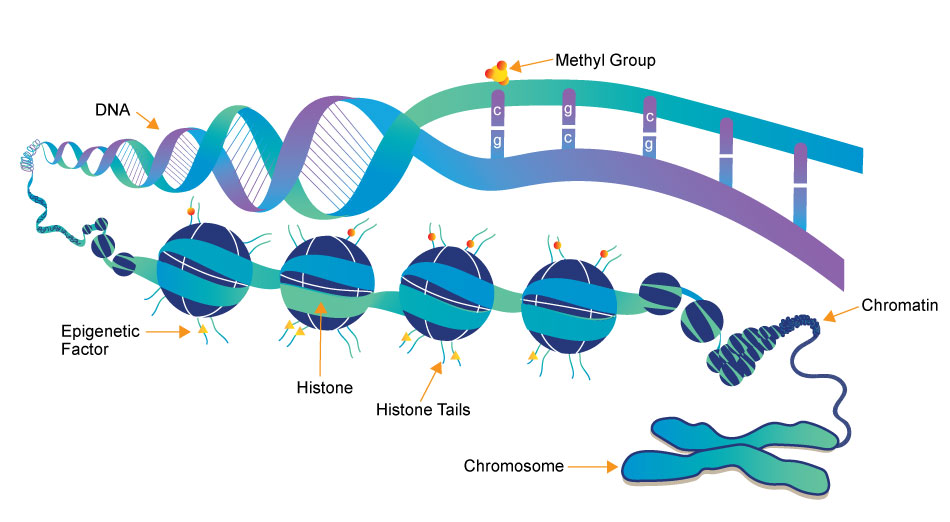Epigenetics


Epigenetics research delves into the molecular mechanisms that control gene expression and cellular traits without altering the underlying DNA sequence. One crucial aspect of this field is the role of small molecules, which act as powerful regulators of epigenetic modifications. These small compounds, typically comprising a few dozen to a few hundred atoms, have emerged as essential tools in understanding and manipulating the epigenome.
- DNA Methylation Inhibitors: Small molecules like 5-azacytidine and 5-aza-2'-deoxycytidine are DNA methyltransferase inhibitors. They block the addition of methyl groups to DNA, leading to DNA demethylation. This can reactivate silenced genes, potentially offering therapeutic avenues for conditions like cancer.
- HDAC inhibitors: HDACs remove acetyl groups from histone proteins, contributing to gene repression. Small molecule HDAC inhibitors, such as Vorinostat and Romidepsin, can reverse this process by increasing histone acetylation, allowing genes to be more accessible for transcription. These inhibitors are being explored for cancer therapy and other conditions.
- Histone Methyltransferase Inhibitors: Small molecules like GSK126 inhibit specific histone methyltransferases, affecting histone methylation patterns. This can alter gene expression, making them promising candidates for cancer and other diseases with epigenetic dysregulation.
- RNA Modulators: Small molecules can also target non-coding RNAs involved in epigenetic regulation. For instance, small molecules called small interfering RNAs (siRNAs) can be designed to target and degrade specific long non-coding RNAs, influencing gene expression.
- Epigenetic Reader Domain Inhibitors: These small molecules target proteins that recognize and bind to specific epigenetic marks. Examples include inhibitors of bromodomain-containing proteins (BET inhibitors), which can disrupt gene regulation by interfering with protein-DNA interactions.
Small molecules in epigenetics research not only provide insights into the fundamental biology of gene regulation but also hold immense promise for developing novel therapeutics. Their ability to selectively modulate specific epigenetic marks and pathways has led to ongoing clinical trials and drug development efforts for various diseases, including cancer, neurological disorders, and inflammatory conditions. Understanding and harnessing the power of these small molecules is at the forefront of modern epigenetics research, offering new hope for precision medicine and targeted therapies.
3 key components involved in the regulation of epigenetic modifications
Epigenetics Writer
Epigenetics writers are enzymes responsible for adding chemical marks or modifications to DNA or histone proteins. These marks include DNA methylation (addition of methyl groups to DNA) and histone modifications (such as acetylation, methylation, phosphorylation, etc.).
Epigenetics Reader
Function: Epigenetics readers are proteins that can recognize and bind to specific epigenetic marks on DNA or histones. These reader proteins interpret the epigenetic code and facilitate downstream cellular processes, such as gene activation or repression.
Epigenetics Eraser
Function: Epigenetics erasers are enzymes responsible for removing or reversing epigenetic marks on DNA or histones. This process allows for the dynamic regulation of gene expression and the resetting of epigenetic states during various stages of development and in response to environmental changes.
-
EZH2 抑制剂
Gambogenic acid 是藤黄中的活性成分,具有抗癌活性。Gambogenic acid 作为 EZH2 的有效抑制剂,特异性并共价地结合到 EZH2-SET 领域内的 Cys668,并诱导 EZH2 泛素化。 -
anticancer agent
5,7,4'-Trimethoxyflavone is isolated from Kaempferia parviflora (KP), a renowned medicinal plant from Thailand. 5,7,4'-Trimethoxyflavone induces apoptosis, as evidenced by increments of sub-G1 phase, DNA fragmentation, annexin-V/PI staining, the Bax/Bcl-xL ratio, proteolytic activation of caspase-3, and degradation of poly (ADP-ribose) polymerase (PARP) protein. 5,7,4'-Trimethoxyflavone is significantly effective at inhibiting proliferation of SNU-16 human gastric cancer cells in a concentration-dependent manner. -
HDAC6 抑制剂
Tubastatin A 是一种强效的 HDAC6 抑制剂,其 IC50 值为 15 nM。 -
pan-HDAC 抑制剂
Quisinostat dihydrochloride (JNJ-26481585 dihydrochloride) 是一种口服可用的、强效的全谱 HDAC 抑制剂,其 IC50 分别为 HDAC1 的 0.11 nM、HDAC2 的 0.33 nM、HDAC4 的 0.64 nM、HDAC10 的 0.46 nM 和 HDAC11 的 0.37 nM。Quisinostat dihydrochloride 具有广谱的抗肿瘤活性。 -
Pdia3/ERp57 activator, STAT3 抑制剂
Diosgenin palmitate,也被称为Diosgenin hexadecanoate,是Diosgenin的己十六酸酯。Diosgenin是一种植物甾体皂苷元,是通过酸、强碱或酶对皂苷进行水解后的产物,这些皂苷提取自薯蓣类野生山药的块茎,如Kokoro山药。 -
HDAC1 and HDAC3 抑制剂
Suberoyl bis-hydroxamic acid(Suberohydroxamic acid;SBHA)是一种具有竞争性和细胞渗透性的 HDAC1 和 HDAC3 抑制剂,其ID50值分别为0.25微米和0.30微米。 -
SIRT1/SIRT3 抑制剂
4'-溴白藜芦醇是一种强效的去乙酰酶抑制剂,能够抑制去乙酰酶sirtuin 1 (SIRT1) 和 3 (SIRT3)。 - Phoenixin-20(PNX-20)是一种在脊椎动物中具有类似激素作用的生物活性肽,能够刺激下丘脑-垂体-性腺激素并调节哺乳动物的生殖过程。Phoenixin-20通过CREB-PGC-1α途径促进神经元线粒体的生物生成。Phoenixin-20具有抗焦虑效果。




